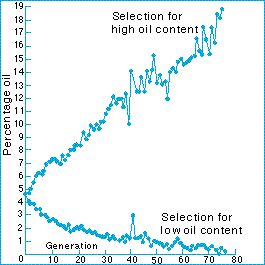Quantitative genetics - How can quantitative genetics be applied?

A population can only respond to artificial selection for as long as the directional selection lasts.
Consider, for example, the longest running controlled artificial selection experiment. Since 1896, corn has been selected, at the State Agricultural Laboratory in Illinois, for (among other things) either high or low oil content. As the graph shows, even after 76 generations the response to selection for high oil content was not exhausted. However, it will come to a stop eventually. As the corn is selected for increased oil content, the genotypes encoding for high oil content will increase in frequency and be substituted for genotypes for lower oil content.
This process can only proceed so far. Eventually all the individuals in the population will come to have the same genotype for oil content. At the loci controlling oil content, no additive genetic variance will then be left; heritability will have been reduced to zero and the response to artificial selection will come to a stop.
The response to directional selection is controlled by the heritability of a character. The relation between the selection differential, response, and heritability can be used to estimate one of the variables if the other two are known. Sustained selection will use up the heritable variation, and the response will then come to a stop.
Figure: response of corn (Zea mays) artificially selected for high or low oil content. The experiment began in 1896 when, from a population of 163 corn ears, the high line was formed from the 24 ears highest in oil content and the low line from the 12 ears with the lowest oil content. From Dudley (1977).
| Next |



